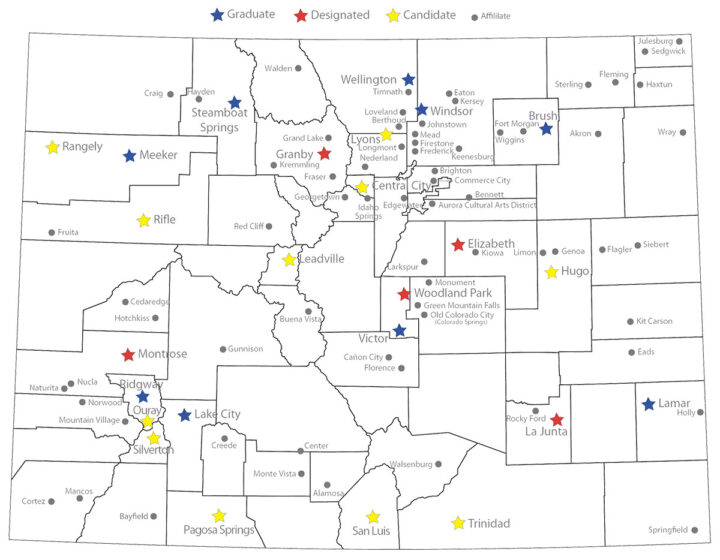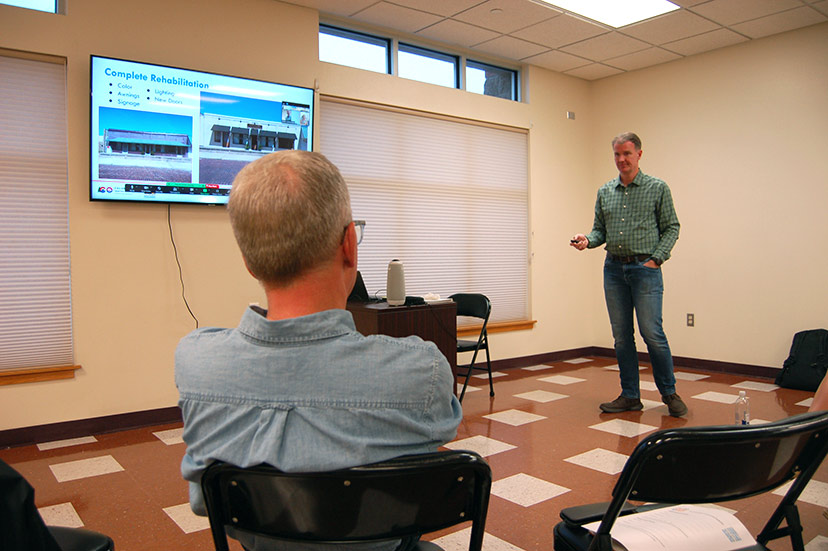PHOTO: Colorado Main Street architect Larry Lucas runs through a slide show of ideas, related to building facade renovation, August 23, 2023.
As a Main Street America™ Coordinating Program, Colorado Main Street helps to lead a powerful, grassroots network of over 40 Coordinating Programs and over 1,200 neighborhoods and communities across the country committed to creating high-quality places and to building stronger communities through preservation-based economic development…
— from the Colorado Department of Local Affairs website.
There’s some good news about Pagosa’s downtown.
And there’s some bad news.
First the good news.
Three representatives from the Colorado Department of Local Affairs “Main Street” office — Program Coordinator Gayle Langley, Architect Larry Lucas, and a woman named Jessica (I didn’t catch her last name) who works in the Main Street office in Durango — were in Pagosa Springs this week, to tour downtown, meet with property owners, and give a public presentation at the Ross Aragon Community Center, promoting a new ‘Facade Improvement Grant’ program aimed at sprucing up downtown buildings, with grants worth up to $2,000.
The Main Street America program was established as a program of the National Trust for Historic Preservation in 1980 as a way to address issues facing older (historic?) downtowns during a time when city dwellers were abandoning some of America’s downtown districts for the suburbs. As the national website states:
Working with a nationwide network of coordinating programs and local communities, Main Street has helped over 2,000 communities across the country bring economic vitality back downtown, while celebrating their historic character, and bringing communities together.
An exciting new chapter for the organization began on July 1, 2013, when the Main Street program launched as an independent subsidiary of the National Trust for Historic Preservation. This transition enables Main Street to build on its three-decade record of success, with new leadership and new resources that will help communities respond to evolving needs and opportunities in the commercial district revitalization field.
The Planning Department at Pagosa’s Town Hall has been working towards ‘Main Street’ membership and certification for several years now.
Because we do have a ‘Main Street’… although it also happens to be a major highway: Highway 160, which barrels through the historic downtown district, allowing cars and trucks to pass through, heading east or west.
Whether we will still have a ‘Main Street’ three years from now? That might be a question worth considering.
And this question was indeed considered, albeit briefly, on Wednesday evening at the Community Center. More about that, later.
The character of our Main Street — or should we say, the character of the buildings facing the Main Street — changes as Highway 160 heads west up Put Hill. (Pronounced “Putt Hill”) The flanking neighborhood becomes progressively more ‘suburban’ in appearance. Many undeveloped properties. Some auto repair shops. A large marijuana dispensary. A combination restaurant-bar-mini-golf venue. A couple of tire repair shops. A Sonic drive-in. A Speedway gas-station-convenience-store. A golf course. A Walmart store.
But our focus, for now, is not west of downtown — where about 80% of the community lives — but rather a “Main Street” district. Pagosa’s more ‘historical’ business district, located between the Highway 160-Highway 84 intersection and running through downtown to the Ruby Sisson Library on South 8th Street.
Also included in the ‘Main Street’ district is Lewis Street.

Back in the 1970s, some American cities and towns were slowly dying as people fled downtown to buy their 1/4-acre dream property in the suburbs. This flight from downtown was encouraged by federal and state housing policies aimed at the idea that every nuclear family ought to live in a separate nuclear house, ideally with a nuclear lawn in the front yard and possibly a nuclear swimming pool — or at least a swing set — in the back yard.
And two cars in the driveway. And a shopping mall within easy driving distance.
In other words, our governments promoted the idea every family ought to live in the suburbs. As a result, many historical downtown districts found themselves struggling, economically and socially. Downtown business districts began to falter, as shops and offices closed their doors… and downtown buildings fell into disrepair.
This was concerning to ‘historic preservationists’ and especially, perhaps, to the federally-chartered National Trust for Historic Preservation.
One approach to try and ‘revitalize’ struggling downtowns was to demolish older buildings and replace them with parking lots.

But the new parking lots didn’t really help matters, because what downtown districts needed most were attractions — shopping, theater, concerts, athletic events, parks — not ugly parking lots.
So the National Trust looked around for a revitalization model that worked… with the primary goal being, of course, historic preservation. But you can’t easily afford to preserve a building when it’s perpetually vacant and generating no income.
Most of the Wednesday evening Main Street presentation was led by Colorado’s official Main Street architect, Larry Lucas, who ran us through his ideas about how to make buildings look “historical”. The essential theory seems to be, if you make your downtown buildings look similar to how they once looked — brand new, in, say, 1910 — you will enhance the economic vitality of your downtown.
There is money available — “free money”, courtesy of Colorado Main Street — to help Pagosa make its Main Street property look more ‘historical’. As much as $2,000 is available, per building.
Enough to pay for a new coat of paint?

The Main Street presentation at the Community Center may have come a bit late in the ‘Facade Improvement Grant’ application process, however, because the applications (made by the property owner, which is not necessarily the business occupying the building) need to be submitted by this Friday, September 1. If the property is awarded funding, the improvement project needs to be completed by December 31, 2023.
Learn more about the Facade Improvement Grant Program here.
According to the map on the DOLA website, only nine Colorado communities have thus far have met the prerequisites and requirements necessary to be designated as a “Graduate” of the Main Street Program. To graduate, you start as an ‘Affiliate’… then you become a ‘Candidate’… and then you need to become ‘Designated’… and finally, at the end, you get your “Graduate” diploma.
About four dozen Colorado towns are signed on as ‘Affiliate’ members of the program. The Town of Pagosa Springs has been, for many years, an Affiliate member of Colorado Main Street Program. It’s easy for a town to join as an Affiliate; you simply send DOLA a letter expressing your interest. No obligation; nothing to buy. But the perks are also limited.
As we see, Pagosa has now been promoted to the “Candidate” category. Sort of like being a sophomore in college?

Meanwhile, the Town has presumably been getting the newsletters and updates about the ‘Official Main Street Communities’ that benefit from the full range of grants and technical assistance provided by DOLA. Recently, the Town contracted with the Pagosa Springs Community Development Corporation (PSCDC) to coordinate an effort to become a “Graduate” Colorado Main Street community.
First step: create a Main Street Advisory Board.
Second step: get the new Board to agree on what downtown Pagosa Springs needs most.
Fresh paint? That doesn’t appear to be the Advisory Board’s primary concern.
Read Part Two, tomorrow…

